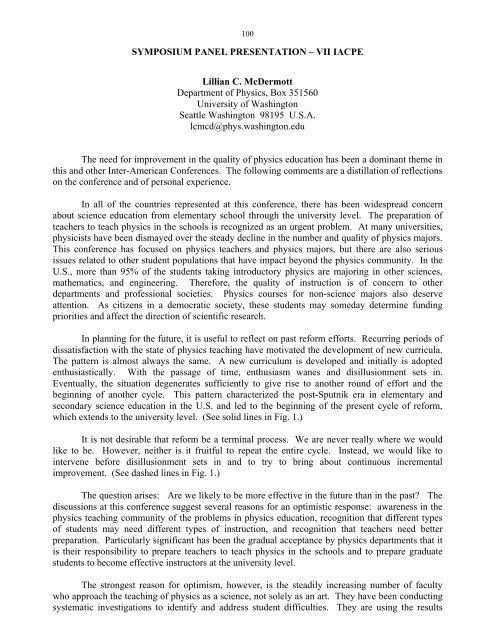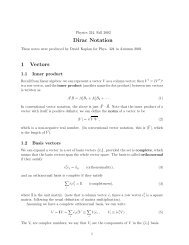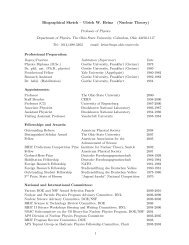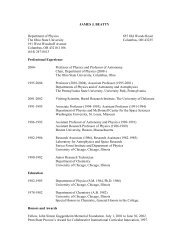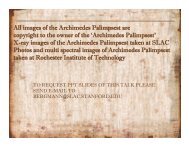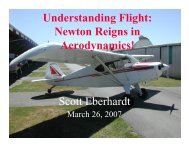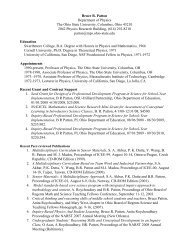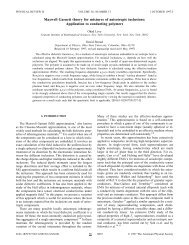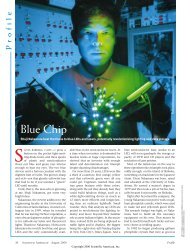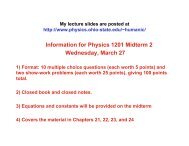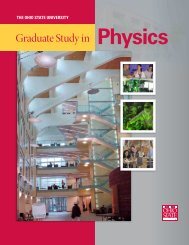Brasil Final Report - Department of Physics - The Ohio State University
Brasil Final Report - Department of Physics - The Ohio State University
Brasil Final Report - Department of Physics - The Ohio State University
Create successful ePaper yourself
Turn your PDF publications into a flip-book with our unique Google optimized e-Paper software.
100<br />
SYMPOSIUM PANEL PRESENTATION – VII IACPE<br />
Lillian C. McDermott<br />
<strong>Department</strong> <strong>of</strong> <strong>Physics</strong>, Box 351560<br />
<strong>University</strong> <strong>of</strong> Washington<br />
Seattle Washington 98195 U.S.A.<br />
lcmcd@phys.washington.edu<br />
<strong>The</strong> need for improvement in the quality <strong>of</strong> physics education has been a dominant theme in<br />
this and other Inter-American Conferences. <strong>The</strong> following comments are a distillation <strong>of</strong> reflections<br />
on the conference and <strong>of</strong> personal experience.<br />
In all <strong>of</strong> the countries represented at this conference, there has been widespread concern<br />
about science education from elementary school through the university level. <strong>The</strong> preparation <strong>of</strong><br />
teachers to teach physics in the schools is recognized as an urgent problem. At many universities,<br />
physicists have been dismayed over the steady decline in the number and quality <strong>of</strong> physics majors.<br />
This conference has focused on physics teachers and physics majors, but there are also serious<br />
issues related to other student populations that have impact beyond the physics community. In the<br />
U.S., more than 95% <strong>of</strong> the students taking introductory physics are majoring in other sciences,<br />
mathematics, and engineering. <strong>The</strong>refore, the quality <strong>of</strong> instruction is <strong>of</strong> concern to other<br />
departments and pr<strong>of</strong>essional societies. <strong>Physics</strong> courses for non-science majors also deserve<br />
attention. As citizens in a democratic society, these students may someday determine funding<br />
priorities and affect the direction <strong>of</strong> scientific research.<br />
In planning for the future, it is useful to reflect on past reform efforts. Recurring periods <strong>of</strong><br />
dissatisfaction with the state <strong>of</strong> physics teaching have motivated the development <strong>of</strong> new curricula.<br />
<strong>The</strong> pattern is almost always the same. A new curriculum is developed and initially is adopted<br />
enthusiastically. With the passage <strong>of</strong> time, enthusiasm wanes and disillusionment sets in.<br />
Eventually, the situation degenerates sufficiently to give rise to another round <strong>of</strong> effort and the<br />
beginning <strong>of</strong> another cycle. This pattern characterized the post-Sputnik era in elementary and<br />
secondary science education in the U.S. and led to the beginning <strong>of</strong> the present cycle <strong>of</strong> reform,<br />
which extends to the university level. (See solid lines in Fig. 1.)<br />
It is not desirable that reform be a terminal process. We are never really where we would<br />
like to be. However, neither is it fruitful to repeat the entire cycle. Instead, we would like to<br />
intervene before disillusionment sets in and to try to bring about continuous incremental<br />
improvement. (See dashed lines in Fig. 1.)<br />
<strong>The</strong> question arises: Are we likely to be more effective in the future than in the past? <strong>The</strong><br />
discussions at this conference suggest several reasons for an optimistic response: awareness in the<br />
physics teaching community <strong>of</strong> the problems in physics education, recognition that different types<br />
<strong>of</strong> students may need different types <strong>of</strong> instruction, and recognition that teachers need better<br />
preparation. Particularly significant has been the gradual acceptance by physics departments that it<br />
is their responsibility to prepare teachers to teach physics in the schools and to prepare graduate<br />
students to become effective instructors at the university level.<br />
<strong>The</strong> strongest reason for optimism, however, is the steadily increasing number <strong>of</strong> faculty<br />
who approach the teaching <strong>of</strong> physics as a science, not solely as an art. <strong>The</strong>y have been conducting<br />
systematic investigations to identify and address student difficulties. <strong>The</strong>y are using the results<br />
from this research as a guide for the development <strong>of</strong> curriculum that matches the needs <strong>of</strong> students.


